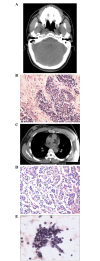Male breast metastases from nasopharyngeal carcinoma: A case report and literature review
- PMID: 24765181
- PMCID: PMC3997684
- DOI: 10.3892/ol.2014.1894
Male breast metastases from nasopharyngeal carcinoma: A case report and literature review
Abstract
Nasopharyngeal carcinoma (NPC) is known for its high rate of regional lymph node and distant metastasis. However, NPC rarely metastasizes to the breast and, to the best of our knowledge, only four well-documented cases of breast metastasis have previously been reported in the literature, all of which are female. A 49-year-old male was diagnosed with NPC and developed a right breast mass five months later. Breast fine needle aspiration confirmed an abundance of metastatic squamous cells within the thickened tissue. The current study presents the first male case of breast metastases from NPC to broaden the clinical database.
Keywords: breast; male; metastasis; nasopharyngeal carcinoma.
Figures

Similar articles
-
Nasopharyngeal Carcinoma With Bilateral Breast Metastasis: A Report of an Elusive Case.Cureus. 2022 Jul 31;14(7):e27497. doi: 10.7759/cureus.27497. eCollection 2022 Jul. Cureus. 2022. PMID: 36060330 Free PMC article.
-
De novo male breast metastases from nasopharyngeal carcinoma: a case report.J Med Case Rep. 2024 Jan 30;18(1):36. doi: 10.1186/s13256-024-04353-1. J Med Case Rep. 2024. PMID: 38287377 Free PMC article.
-
Breast metastasis from nasopharyngeal carcinoma: A case report and review of the literature.Oncol Lett. 2013 Jun;5(6):1859-1861. doi: 10.3892/ol.2013.1303. Epub 2013 Apr 12. Oncol Lett. 2013. PMID: 23833656 Free PMC article.
-
Thyroid metastasis from small cell lung carcinoma: a case report and review of the literature.J Med Case Rep. 2015 Oct 7;9:231. doi: 10.1186/s13256-015-0707-4. J Med Case Rep. 2015. PMID: 26445938 Free PMC article. Review.
-
Fine-needle aspiration cytology of metastatic squamous-cell carcinoma arising in a pilonidal sinus, with literature review.Diagn Cytopathol. 1999 Jun;20(6):367-70. doi: 10.1002/(sici)1097-0339(199906)20:6<367::aid-dc7>3.0.co;2-s. Diagn Cytopathol. 1999. PMID: 10352909 Review.
Cited by
-
Nasopharyngeal Carcinoma With Bilateral Breast Metastasis: A Report of an Elusive Case.Cureus. 2022 Jul 31;14(7):e27497. doi: 10.7759/cureus.27497. eCollection 2022 Jul. Cureus. 2022. PMID: 36060330 Free PMC article.
-
Unusual axillary metastasis of recurrent nasopharyngeal cancer: A case report.Medicine (Baltimore). 2017 May;96(20):e6854. doi: 10.1097/MD.0000000000006854. Medicine (Baltimore). 2017. PMID: 28514301 Free PMC article.
-
Nasopharyngeal carcinoma metastasis to the breast.Saudi Med J. 2020 Oct;41(10):1130-1134. doi: 10.15537/smj.2020.10.25420. Saudi Med J. 2020. PMID: 33026055 Free PMC article. Review.
-
Combined effects of Lenvatinib and iodine-131 on cell apoptosis in nasopharyngeal carcinoma through inducing endoplasmic reticulum stress.Exp Ther Med. 2018 Oct;16(4):3325-3332. doi: 10.3892/etm.2018.6652. Epub 2018 Aug 23. Exp Ther Med. 2018. PMID: 30233679 Free PMC article.
-
De novo male breast metastases from nasopharyngeal carcinoma: a case report.J Med Case Rep. 2024 Jan 30;18(1):36. doi: 10.1186/s13256-024-04353-1. J Med Case Rep. 2024. PMID: 38287377 Free PMC article.
References
-
- Luo J, Chia KS, Chia SE, et al. Secular trends of nasopharyngeal carcinoma incidence in Singapore, Hong Kong and Los Angeles Chinese populations, 1973–1997. Eur J Epidemiol. 2007;22:513–521. - PubMed
-
- Sham JS, Choy D, Wei WI. Nasopharyngeal carcinoma: orderly neck node spread. Int J Radiat Oncol Biol Phys. 1990;19:929–933. - PubMed
-
- Yi JL, Gao L, Huang XD, et al. Nasopharyngeal carcinoma treated by radical radiotherapy alone: ten-year experience of a single institution. Int J Radiat Oncol Biol Phys. 2006;65:161–168. - PubMed
LinkOut - more resources
Full Text Sources
Other Literature Sources
